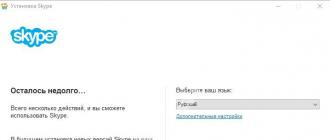When restoring an iPhone, iTunes sometimes gives an unknown error with a number, without which it is impossible to continue working with a mobile device. Troubleshooting methods vary depending on the fault number that caused the iPhone to fail.
Error classification
Apple Support divides crashes by numbers into several categories on a special page on the site. However, you will not find some codes. For example, there is no number 52 on the support page, because iTunes does not crash with such a code. Error 47 is also not listed, although some users complain that due to a failure with such a number, they cannot restore their iPhone.
If you are experiencing Issue 47, there may be several reasons for it:
- Breakdown of the microcircuit of the modem part.
- Failure of the modem processor.
- Liquid penetration into the modem part.
As you can see, error 47 is related to a hardware problem. Therefore, if you encounter Fault 47 while restoring iPhone, take your mobile device to a service center. Even the master does not immediately determine the exact reasonthe appearance of a problem with number 47, so it is better not to risk it trying to repair it yourself.
Communication errors (1671, 3004, 3014, 3194)
If iTunes displays a message with the numbers 1671, 3004, 3014, 3194, or 9006 when restoring your iPhone, then you are dealing with problems that prevent your computer from establishing a connection with the Apple server or mobile device. If you encounter problems 3004, 3014 3194, 9006, try restarting your computer first. If that doesn't work, close apps that are running in the background, leaving only iTunes. Disable your firewall and antivirus. Since failures with numbers 3004, 3014 3194, 9006 occur due to the inability to establish a connection to the server, disabling the firewall will help remove the protective shield. 
If these methods do not help to get rid of errors 3004, 3014 3194, 9006, then try the following methods:

An extra entry will end with gs.apple.com. If you find one, remove it immediately and save the hosts file. After editing the hosts, error messages 3004, 3014 3194, 9006 should no longer appear when restoring an iPhone. If problems with numbers 3004, 3014 3194, 9006 appear when restoring iPhone on a Mac computer, then open hosts through the terminal using the command "sudo nano / private / etc / hosts".
If iTunes displays error 3194, when the recovery line is 2/3 full, then with a high degree of probability you have encountered a hardware problem - a damaged modem or an iPhone power module.
If the device cannot be restored due to a problem with the modem, please contact the service center for assistance, as you cannot fix the problem yourself.
Errors 14 and 4005
IPhone recovery crashes with numbers 14 and 4005 usually occur when problems are detected with a device connected via USB. Error 14 means that iTunes detected a violation of the integrity of the firmware file during the restore process. Fault 4005 usually indicates that there is some kind of cable or port problem on the computer. 
To fix error 14 or 4005:
- Use the original iPhone cable.
- Connect the device to a different port. Try to use the connectors located on the back of the system unit, then you will give less chances for errors like 14 and 4005.
- Connect iPhone to another computer.
If error 14 or 4005 persists, try putting your phone into DFU mode before restoring. If that doesn't fix crash 14 or 4005, download the firmware manually and select the desired ipsw file by holding down the Shift key while pressing the Restore button. 
Errors with numbers 14 and 4005 appear when trying to update the firmware by jumping through the version (for example, from iOS 7 directly to iOS 9). Please select the correct firmware version to avoid issue 14 or 4005.
Error 21
Failure number 21 occurs when the device is not entered into DFU mode. To eliminate the cause of error 21, use programs like redsn0w to transfer the phone to DFU. 
Especially often the owners of iPhones, on which the jailbreak procedure was carried out, encounter failure 21. In addition, failure 21 can occur due to the fact that the battery is not fully charged. Accordingly, in order to fix the problem with number 21, you need to put the smartphone on charge. 
Restore via iTunes is an extreme measure that the user takes if he cannot fix one or another software failure of the iPhone. Unfortunately, sometimes this procedure, in turn, is interrupted by an error. What if you can't restore your device via iTunes? In this article, we will answer the question.
In general, there are two ways to restore an iPhone using iTunes. The first method is "light" - it assumes that your device is still functional, but, for example, it is a little buggy, and you want to remove all bugs with the help of recovery. In this case, you need to connect the iPhone to a PC with iTunes installed, wait until the program recognizes the device (that the gadget is identified, it will signal the appearance of an icon in the form of a phone in the main menu of the program), go to the "Overview" section and click the "Restore iPhone ".
It's very simple, but there are worse situations. For example, you set the iPhone to update, but forgot that the charge is not enough and it turned off when the update was not performed, and now the smartphone refuses to respond to any actions, including it does not turn on. Or, for example, you decided to install a program from an unverified source, and there was a virus that turned, again, the device into a "brick", refusing to even turn on. Is there a chance in such situations to return the smartphone to a usable state?
Do not be alarmed, there is a way out of this situation - you just need to put the device into one of the emergency modes - Recovery Mode or DFU. The first is activated through the platform, the second at the hardware level. That is, if Recovery Mode does not respond, DFU will always come to the rescue.
To activate Recovery Mode, hold down the Home button, then, without releasing it, connect the device to a PC with iTunes, when the program icon and the image of the charge cable light up on the smartphone screen, release Home. At the same time, iTunes will inform you about the detection of the iPhone in recovery mode and will offer to start the recovery process.

To put the smartphone into DFU mode, hold down Home + Power, release Power after 10 seconds, connect the iPhone to the computer, and wait for iTunes to signal that the device has been detected in recovery mode (no icons should appear on the screen of the device itself!), then release Home and start the procedure.
What to do if iTunes fails to restore iPhone?
Unfortunately, sometimes for some reason iTunes fails to complete the restore procedure - it is interrupted by an error. Do not worry, this is not the end of the world, most likely, the situation is easily corrected.
There can be many reasons why iTunes refuses to restore the device, but most often the problem is of a software nature.
And therefore, first of all, you need to restart the program and the computer, and if your iPhone is not in a brick state, reset it too. Perhaps after this simple step, you will succeed.
Software Update
If restarting does not help, you need to make sure that there are no software conflicts - first of all, we check which version of iTunes is installed on your computer, perhaps the program simply needs to be updated. Also, it will not be superfluous to update all the other software installed on the PC. You don't even think how often outdated programs become the cause of certain crashes.

To update the software on a Windows PC, you can go through the "Start" menu to the Windows Update Center, and on a Mac you need to go to the "Updates" section of the App Store.
Disable security programs
Another common cause of software conflicts is the overly responsible work of antivirus programs. Your firewall or antivirus may have put iTunes on the list of suspicious programs and is interfering with its operation. To check if this situation is relevant in your case, disable all security programs during the recovery.
Editing the hosts file
And finally, another reason for software glitches is hosts file errors. We will not go into long explanations of what this file is and why it is needed, it is not so important in this case. You just need to make it correct. How? In this article on the Apple support site, you can read how to find and edit a file on Mac, this article will help you find hosts on Windows, and the editing order will be the same as for Mac.
Hardware problems
If you are unlucky and the iPhone is not recovering, despite the fact that you have taken all the above measures, then it is time to suspect hardware problems. First of all, you need to use another USB port to connect your iPhone. If this does not help, perhaps the matter is in the connecting cable - keep in mind that in this case you must use either the original wire or with the MFi marking, which means “Made for iPhone”.

If everything is in order with the cable and ports and you ruled out the software reasons, but the recovery is still interrupted, the problem may be in the PC or iPhone itself. Try to use another computer, if recovery is interrupted on it too, then it's time for you to take your "apple" in hand and go with it to the service.
Let's summarize
Using iTunes restore can fix certain iPhone glitches, but sometimes it won't restore. Why is the iPhone not restored through aytyuns? There can be many reasons, both software and hardware. If you could not fix the problem on your own, we recommend that you first contact Apple support, and if it does not help, take the device to the service and, we hope, they can still make it restored!
When a person tries to restore their iPhone, but problems begin, many questions arise. To use the device in normal mode and troubleshoot, you need to figure out why this or that error appeared and what it means.
Description of common errors in iPhone recovery
1. One of the frequent questions asked by users is: "what to do if iPhone cannot be restored, error 3194 interferes with this process." This means that iTunes cannot request the required SHSH from the server. You can solve this problem as follows: you need to check the version of your iTunes program and install the latest. More often than not, this is the solution to the problem. After that, restore your phone.
Enlarge
Another method is performed if the previous one did not show results. This is done easily:
- Exit the program and find the hosts file in the C: \\ Windows \\ System32 \\ drivers \\ etc \\ folder.
- Next, you need to open the file with notepad and delete the line "74.208.105.171 gs.apple.com", and then save the document.
- After that, you need to connect the device to your computer by launching iTunes and enter DFU mode.
- To do this, hold the lock button and after 3 seconds hold the main button with it. Then, after 10 seconds, release the lock and wait without releasing the "Home" button. You will see a gray screen on your device.
- After that, you can try to restore the firmware again.
If all this works out, it is best to delete the line again from the hosts file and in the future it will be possible to update from the official servers.
There is also another way to restore the system using special programs, for example, TinyUmbrella, which will help fix the problem.
2. When your iPhone doesn't want to recover and error 1 appears, there can be several reasons.
- You do not have the latest version of iTunes for this firmware.
- You are trying to install an older iOS system.
What to do in this case?
- Update iTunes.
- You can make sure you are using the most recent firmware on your phone, or simply install the newest one.
- It is also best to reconnect the USB cable to a different port.
- Try restarting your computer.
3. In case of error 9, the USB cable itself may be to blame.
- Try to examine it in detail and check for breakdowns.
- Try plugging into a different port on your computer.
- Restart your computer or use a new cable to make sure everything works.
4. Error 1015 is common when your iPhone's modem version is changed to a lower version. The problem appears if the Baseband of the device has a newer number than the one in the firmware. To solve the problem, do the following.
iTunes is a program that lets you manage your Apple devices. As with any application, it crashes too. If your iPhone is not being restored through iTunes, then in this article you will find tips to help you solve the problem. There are many reasons for difficulties with recovery, and we will talk about each of them in detail.
What to do if iTunes won't restore iPhone, iPod or iPad
Please update the app. If iTunes does not restore the iPhone, then the first step is to check for a new version of the program. If it is, then update to the most current version. After that it is recommended to restart the PC.
Reboot your devices. If this error occurs, you also need to restart both the computer and the device being restored (iPhone 4s, 5s, 6, etc.). To perform this operation on your smartphone, hold down the power key and press the Home button for ten seconds. The phone will turn off and then turn it on as usual.

Replace USB cable. If you are unable to restore your iPhone, then it may be due to the use of a non-original cord. In this case, you need to purchase the original one. But if you are sure that the cable is real, check it for damage. If available, purchase a new original wire.
Use a different USB port. If you have failed to restore your smartphone and have checked your cable, try moving it to a different port on your PC. When using auxiliary devices to connect, disconnect them and connect the device directly.
Reinstall the app. Sometimes users cannot restore their iPhone due to a system failure that prevents the program from working correctly. In this case, completely remove Aytyuns (read more about this in our other article), then restart your PC. Next, go to the developer's official website and install the required version of the application.
Method 6
Edit the Hosts file. Usually viruses make changes to this file. Therefore, check your system with an antivirus. If viruses are found, eliminate them. After that it is recommended to restart the PC. Now restore the hosts file. You can read more about this on this website.

Method 7
Disable your antivirus. Sometimes the antivirus raises a false alarm. Therefore, turn off your smartphone while restoring it. If this solved your problem, then exclude iTunes from the list of programs in the antivirus settings.
Method 8
Restore the device via DFU mode. You need to use this mode just in case of problems. First, turn off your smartphone completely, and then connect it to your PC using a cable. Next, open iTunes. To enter DFU mode, first hold the power button for three seconds. Without releasing the first button, hold down the "Home" key and hold them simultaneously for both ten seconds. Then release the power button but hold the Home button until a window appears on the PC screen.


Method 9
Use a different computer. Perhaps the problem is lurking in your computer. Try to perform the operation on a different PC.
Method 10
Check your device for viruses using an antivirus. Perhaps, it is precisely because of the presence of viruses on the computer that the application does not work correctly.
Hope our information helped to solve the problem. If something doesn't work out for you, ask questions in the comments.






